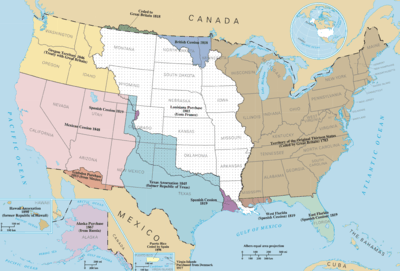Newlands Resolution
.jpg)
The Newlands Resolution was an Act of Congress to annex the Republic of Hawaii and create the Territory of Hawaii against the express wishes of the overwhelming majority of the indigenous population and without a referendum of any kind.[1][2] It was written by and named after United States Congressman Francis G. Newlands.
In 1898 President of the United States William McKinley signed the treaty of annexation for Hawaii, but it failed in the Senate after the 21,000 signatures of the Kū’ē Petitions[3] were submitted. After the failure, Hawaii was annexed by means of joint resolution, called the Newlands Resolution.
It was approved on July 4, 1898 and signed on July 7 by William McKinley. In August of the same year, a ceremony was held on the steps of Iolani Palace to signify the official transfer of Hawaiian sovereignty to the United States.
The Newlands Resolution established a five-member commission to study which laws were needed in Hawaii. The commission included: Territorial Governor Sanford B. Dole (R-Hawaii Territory), Senators Shelby M. Cullom (R-IL) and John T. Morgan (D-AL), Representative Robert R. Hitt (R-IL) and former Hawaii Chief Justice and later Territorial Governor Walter F. Frear (R-Hawaii Territory). The commission's final report was submitted to Congress for a debate which lasted over a year. Congress raised objections that establishing an elected territorial government in Hawaii would lead to the admission of a state with a non-white majority. On July 12, 1898, the Joint Resolution passed and the Hawaiian Islands was annexed by the United States. This allowed duty-free trade between the islands and the mainland, and made the existing American military presence permanent.
The creation of the Territory of Hawaii was the final step in a long history of dwindling Hawaiian sovereignty and divided the local population. Debate between anti-sovereignty and sovereignty activists still exists over the legality of the acquisition of Hawaiian land under the United States constitution.[4][5]
Background of Senate debate
The bombing of the U.S.S. Maine took place in Cuba in February, 1898.[6] That bombing triggered the Spanish–American War, which caused world events to soon force the annexation issue. President Benjamin Harrison submitted a treaty to annex the Hawaiian Islands to the United States Senate for ratification.[7] In 1897, the treaty was blocked due to lobbying by Hawaiian public officials and a petition from native Hawaiians. Only 46 out of 90 senators voted in favor of the resolution, which was more than the required majority but less than the two-thirds required by the Treaty Clause.[8]
See also
- Hawaiian Organic Act, approved in 1900 by Congress to adopt a form of government for the new territory, in supplement of the Newlands Resolution.
References
- ↑ The Spanish-Cuban-American War and the Birth of American Imperialism Vol. 2 ...Philip S. Foner P.414
- ↑ From a Native Daughter: Colonialism and Sovereignty in Hawaiʻi Haunani-Kay Trask P.29
- ↑
- ↑ Twigg-Smith, Thurston (1998). Hawaiian Sovereignty: Do the Facts Matter?. Honolulu: Goodale Pub. p. 239. ISBN 978-0966294514.
- ↑ Trask, Haunani-Kay (1999). From a Native Daughter : Colonialism and Sovereignty in Hawaiʻi. Honolulu: University of Hawaii Press. pp. 13–16. ISBN 978-0824820596 – via eBook Academic Collection (EBSCOhost).
- ↑ , Joint Resolution Website, retrieved on October 29, 2014.
- ↑ , Petition against the Annexation of Hawaii Website, retrieved on October 29, 2014.
- ↑ , History of the Treaty, and Petition Website, retrieved on October 29, 2014.
Further reading
- Hilfrich, Fabian. Debating American exceptionalism: empire and democracy in the wake of the Spanish-American War (Palgrave Macmillan, 2012)
- Osborne, Thomas J. "The Main Reason for Hawaiian Annexation in July, 1898," Oregon Historical Quarterly (1970) 71#2 pp. 161–178 in JSTOR
- Osborne, Thomas J. "Empire Can Wait": American Opposition to Hawaiian Annexation, 1893-1898 (Kent State University Press, 1981)
External links
| Wikisource has original text related to this article: |
